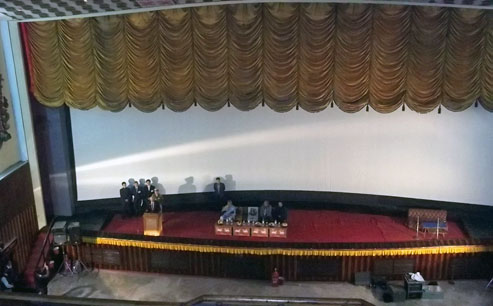AUDIENCE STUNNED BY SIMPLICITY AND EVOCATIVE TONE OF MAESTRO’S [NO LONGER] ‘LOST’ WORK
TSHERING EDEN
GANGTOK, 07 April: Battling the hail and traffic, an eager crowd of Gangtokians made it to Vajra cinema hall for the world premiere of Satyajit Ray’s ‘Sikkim’ on Wednesday evening. The elderly, college and school students, members of the royal family, retired civil servants, in fact people from all walks of life, were present for the much awaited premiere.
Welcoming the guests, Managing Trustee of the Art and Culture Trust [ACT] of Sikkim, Ugyen Chopel, gave a brief background of the film. The chief guest for the premiere, Governor Balmiki Prasad was accompanied to the event by Justice SP Wangdi, cinematographer of the film, Soumendu Roy, and actor-director, Tinu Anand, who assisted Satyajit Ray during the making of the film, were present as special guests.
The film opens with scenic shots of Sikkim with Ray’s voiceover guiding the audience through them. The film played out its brief less than an hour run to frequent gasps along with cheering and clapping from the audience springing from the feelings of nostalgia among the elderly and awe for the younger lot at the sight of Sikkim as it once was.
“It gave me an opportunity to see what Sikkim and its people were like 40 years ago. I am glad I came”, said Binita Lama after the screening.
“It is a regular promotional film on Sikkim, being a local most of the scenes are very familiar to what we see today but yes, seeing what the Lal Bazaar looked like during that time and the fact that it was made decades ago makes it a special one,” is how Tseten put his “Sikkim” experience.
Following the screening, Tinu Anand, Soumendu Roy and Ugyen Chopel spoke to media persons at the Chumbi Residency.
On the filmmaking experience, Mr Anand said that Ray put together a 15-member unit, for whom elaborate arrangements had been made by Chogyal Palden Thondup Namgyal, on a scale and with care that he has never come across anywhere else.
“Around 7 to 8 jeeps had been assigned to us, out of which one was a make-shift kitchen and one a bar, although Ray was not very fond of this fact,” Mr. Anand reminisced.
While Ray was lodged in the State Guest House, the rest of the crew was put up at Green Hotel at MG Marg, he informed. How was Ray convinced to make the film? The cinematographer, Mr. Roy, now around 80 years old, shared that Hope Cooke had requested Dr. Adi Gazdar, a mutual friend, to request the maestro to take the assignment. The lobbying obviously worked.
“We visited Sikkim thrice in the span of a year to shoot this film,” Mr. Anand added.
The film was commissioned by the Chogyal and was shot in 1971.
“We worked with just two 2C cameras and semi-professional sound recording equipment. The film was developed in Chennai’s Gemini Lab while the post-production took place in Kolkata,” informed Mr Roy about the making of the film.
On why the film was ‘lost’, Mr Roy informed that following the merger of the kingdom of Sikkim with India, Ray was asked to cut some scenes which featured the Chogyal in them, which, Ray refused. The cinematographer believes that this was the reason why the film “somehow disappeared”.
It was however not made clear as to who had asked for these cuts to be made.
Ugyen Chopel, went on to add that as such, there is no evidence or document suggesting that film was ever banned and no one really knows where the notion of a ban was born.
Mr Roy further informed that most of the original film is there in the restored print that was screened, except a scene of an archery competition, which he remembers from the original. After the film was made, screenings did take place on invitation in Kolkata and Sikkim, according to Mr Roy.
Mr. Chopel commented that from the reaction of the audience at the screening, he realised that the film works on two levels- originally made to introduce Sikkim to the larger world, the film also has an appeal for the locals here.
“Someone even came and hugged me at the screening. I almost felt like I had made the film,” he said on the kind of reaction the film drew from audiences here.
He went on to offer his sincere apologies for all those who had to be turned away from the screening due to the limited seats available. “We are already in talks for another screening at Vajra soon,” he informed.
‘Sikkim’ will also feature on the 90th birth anniversary of Satyajit Ray at Nandan in Kolkata on 02 May, followed by a screening at the Munich Film Museum on 04 May and also at the Lincoln Centre in New York, Mr Chopel informed.
Plans to screen ‘Sikkim’ across the country are also on the anvil.
Meanwhile, restoration and preservation work on some other films on Sikkim like “The Yankee Queen”, a royal wedding film, silent films, and footage shot by Chogyal Palden Thondup Namgyal are also in the pipeline, he further informed.



It's good to know that the film is finally released for everyone to see. I wish I had been present there to see it with everyone. If I'm not mistaken there were only three copies of the film, one with the chogyal, one in America (with the princess of Sikkim / though the film was in a very bad condition) and one with Satyajit Ray's family, that I'm not sure of. I am very curious as to why the film was banned in Sikkim and some other film festivals abroad during it's release. Well, since I don't think that I'll be able to get my hands on one of the copies...I'll be glad if someone posts a summary/synopsis of the movie {SPOILERS-ACCEPTED}.
ReplyDelete